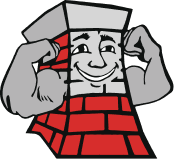Our qualified chimney sweep technicians offer chimney inspections, repairs, and chimney cleaning services in towns like West Hartford, Marlborough, Manchester, Bolton, Colchester, Tolland, East Hampton, Chesire, Southington and the surrounding areas.
 Have You Had An Annual Inspection Yet?
Have You Had An Annual Inspection Yet?
Did you know that The National Fire Protection Association recommends having your chimney inspected at least once per year? According to Standard 211, "Chimneys, fireplaces, and vents shall be inspected at least once a year for soundness, freedom from deposits, and correct clearances. Cleaning, maintenance, and repairs shall be done if necessary." It’s important to note that this standard still applies even if you don’t use your fireplace or chimney system often. Deterioration and blockages can still occur, making the chimney unsafe for use.
It is a great idea to have regular annual chimney inspections to ensure that everything is in working order and operating correctly. Your chimney may be due for a flue cleaning or have other deficiencies that could interfere with the proper use of your fireplace, wood stove, furnace or other heating appliances. Don't risk letting a serious defect turn into a disaster; get your chimney inspected by our qualified professional chimney sweep technicians.
Every technician that performs a chimney inspection is a qualified Chimney Sweep, fully licensed and insured to do work in Connecticut. When our employees arrive at your home they will be driving a marked vehicle, have proper credentials and an ID, and be dressed in our company uniform. We have served all of Connecticut since 1984 and pride ourselves on providing the absolute best chimney services available for our customers.
 When Do I need a Chimney Inspection?
When Do I need a Chimney Inspection?
If you notice that your fireplace, chimney, or heating system is having performance issues, your symptoms may indicate that something is wrong. Don't wait to schedule an inspection. Neglecting this crucial system could result in costly repairs, and possibly even property loss, injuries or death. Each year over 200 million dollars are lost because homeowners were using unsafe chimney & venting systems.
Have you recently purchased a home? If you have yet to have a chimney inspection, you may not know what condition the last owners left the system in. Also, if you plan to upgrade or change your current heating system or add a wood stove, you need to find out if your current chimney system can handle the new venting requirements. Even if you have not used your fireplace in a long time, it’s a good idea to still get an inspection. When you don't use the fireplace much, animals & birds may decide to use your chimney flue for their new home. Their nests can clog your chimney, posing a serious safety hazard. Winter freezing and thawing cycles can also take a toll on masonry and liner materials over many years of exposure. Many times homeowners experience weather-related deterioration that if left unchecked can affect the structural integrity of your chimney and flue.
The Three Levels of Chimney Inspections
The NFPA (National Fire Protection Association) has established industry standards that define the different levels of chimney inspection.
Level 1 Chimney Inspection
Annual inspections that are part of routine maintenance are considered Level I Chimney Inspections. A level one inspection is performed, and is many times done in tandem, with a chimney cleaning. Our qualified chimney technicians will examine the accessible interior and exterior components of your chimney, flue, and fireplace or heating appliance connection. This includes the damper, smoke chamber, firebox, cap, crown and masonry and/or structural elements. The goal is to identify any potential defects or vulnerabilities that could potential problems, including structural or flue defects and problems with connections to appliance venting. Any blockages, creosote and soot build-up or other defects will be reported to you along with suggested remedies.
A Level I inspection is a great way to have peace of mind that your system can provide continued safe use through the heating season.
 Level 2 Chimney Inspection
Level 2 Chimney Inspection
If you have made any changes to your system, such as change in fuel type, chimney relining, furnace replacement or new stove or appliance installation, we recommend a Level II Chimney Inspection. Perhaps you have just purchased the home and are not sure about the condition of the chimney system or have had symptoms of a poorly-operating system. During a Level II inspection, we will perform an in-depth look at the entire chimney, furnace or stove system. Along with the Level 1 criteria, we use a color video inspection tool to do a top-to-bottom look at your chimney. All internal surfaces and joints will be inspected for weaknesses that may compromise performance and safety. A report that details all findings is provided in writing and estimates can be provided for any repairs that may be needed. We never proceed with any repairs prior to your authorization during an inspection.
Level 3 Chimney Inspection
This is the most in-depth inspection offered. Along with the points covered in Levels I and II, the Level III Chimney Inspection may require that portions of your chimney that are areas of concern be opened up or removed for inspection. This can include bricks, flue pipes, interior walls, chimney crowns, caps and other components. This type of inspection is only done when earlier surveys reveal potentially serious problems that require access to site of the problem. This level is needed in less than 2 percent of all inspections, and only when serious problems that require quick attention are detected.



